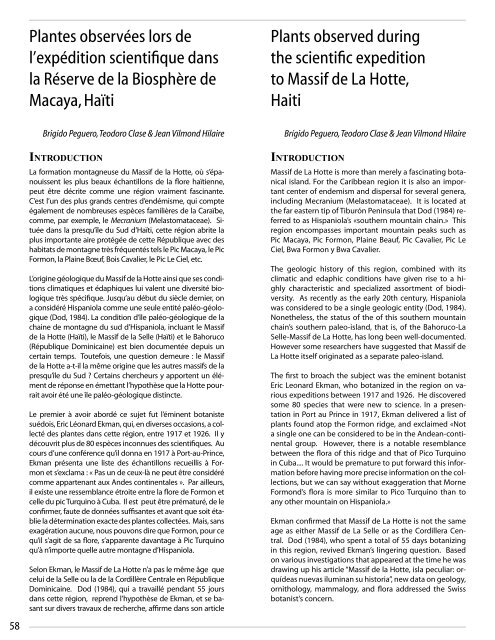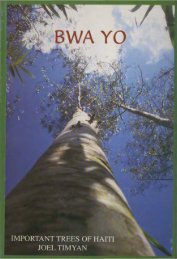Biodiversité - Société Audubon Haiti
Biodiversité - Société Audubon Haiti
Biodiversité - Société Audubon Haiti
You also want an ePaper? Increase the reach of your titles
YUMPU automatically turns print PDFs into web optimized ePapers that Google loves.
58<br />
Plantes observées lors de<br />
l’expédition scientifique dans<br />
la Réserve de la Biosphère de<br />
Macaya, Haïti<br />
Brigido Peguero, Teodoro Clase & Jean Vilmond Hilaire<br />
IntroductIon<br />
La formation montagneuse du Massif de la Hotte, où s’épanouissent<br />
les plus beaux échantillons de la flore haïtienne,<br />
peut être décrite comme une région vraiment fascinante.<br />
C’est l’un des plus grands centres d’endémisme, qui compte<br />
également de nombreuses espèces familières de la Caraïbe,<br />
comme, par exemple, le Mecranium (Melastomataceae). Située<br />
dans la presqu’île du Sud d’Haïti, cette région abrite la<br />
plus importante aire protégée de cette République avec des<br />
habitats de montagne très fréquentés tels le Pic Macaya, le Pic<br />
Formon, la Plaine Bœuf, Bois Cavalier, le Pic Le Ciel, etc.<br />
L’origine géologique du Massif de la Hotte ainsi que ses conditions<br />
climatiques et édaphiques lui valent une diversité biologique<br />
très spécifique. Jusqu’au début du siècle dernier, on<br />
a considéré Hispaniola comme une seule entité paléo-géologique<br />
(Dod, 1984). La condition d’île paléo-géologique de la<br />
chaine de montagne du sud d’Hispaniola, incluant le Massif<br />
de la Hotte (Haïti), le Massif de la Selle (Haïti) et le Bahoruco<br />
(République Dominicaine) est bien documentée depuis un<br />
certain temps. Toutefois, une question demeure : le Massif<br />
de la Hotte a-t-il la même origine que les autres massifs de la<br />
presqu’île du Sud ? Certains chercheurs y apportent un élément<br />
de réponse en émettant l’hypothèse que la Hotte pourrait<br />
avoir été une île paléo-géologique distincte.<br />
Le premier à avoir abordé ce sujet fut l’éminent botaniste<br />
suédois, Eric Léonard Ekman, qui, en diverses occasions, a collecté<br />
des plantes dans cette région, entre 1917 et 1926. Il y<br />
découvrit plus de 80 espèces inconnues des scientifiques. Au<br />
cours d’une conférence qu’il donna en 1917 à Port-au-Prince,<br />
Ekman présenta une liste des échantillons recueillis à Formon<br />
et s’exclama : « Pas un de ceux-là ne peut être considéré<br />
comme appartenant aux Andes continentales ». Par ailleurs,<br />
il existe une ressemblance étroite entre la flore de Formon et<br />
celle du pic Turquino à Cuba. Il est peut être prématuré, de le<br />
confirmer, faute de données suffisantes et avant que soit établie<br />
la détermination exacte des plantes collectées. Mais, sans<br />
exagération aucune, nous pouvons dire que Formon, pour ce<br />
qu’il s’agit de sa flore, s’apparente davantage à Pic Turquino<br />
qu’à n’importe quelle autre montagne d’Hispaniola.<br />
Selon Ekman, le Massif de La Hotte n’a pas le même âge que<br />
celui de la Selle ou la de la Cordillère Centrale en République<br />
Dominicaine. Dod (1984), qui a travaillé pendant 55 jours<br />
dans cette région, reprend l’hypothèse de Ekman, et se basant<br />
sur divers travaux de recherche, affirme dans son article<br />
Plants observed during<br />
the scientific expedition<br />
to Massif de La Hotte,<br />
<strong>Haiti</strong><br />
Brígido Peguero, Teodoro Clase & Jean Vilmond Hilaire<br />
IntroductIon<br />
Massif de La Hotte is more than merely a fascinating botanical<br />
island. For the Caribbean region it is also an important<br />
center of endemism and dispersal for several genera,<br />
including Mecranium (Melastomataceae). It is located at<br />
the far eastern tip of Tiburón Peninsula that Dod (1984) referred<br />
to as Hispaniola’s «southern mountain chain.» This<br />
region encompasses important mountain peaks such as<br />
Pic Macaya, Pic Formon, Plaine Beauf, Pic Cavalier, Pic Le<br />
Ciel, Bwa Formon y Bwa Cavalier.<br />
The geologic history of this region, combined with its<br />
climatic and edaphic conditions have given rise to a highly<br />
characteristic and specialized assortment of biodiversity.<br />
As recently as the early 20th century, Hispaniola<br />
was considered to be a single geologic entity (Dod, 1984).<br />
Nonetheless, the status of the of this southern mountain<br />
chain’s southern paleo-island, that is, of the Bahoruco-La<br />
Selle-Massif de La Hotte, has long been well-documented.<br />
However some researchers have suggested that Massif de<br />
La Hotte itself originated as a separate paleo-island.<br />
The first to broach the subject was the eminent botanist<br />
Eric Leonard Ekman, who botanized in the region on various<br />
expeditions between 1917 and 1926. He discovered<br />
some 80 species that were new to science. In a presentation<br />
in Port au Prince in 1917, Ekman delivered a list of<br />
plants found atop the Formon ridge, and exclaimed «Not<br />
a single one can be considered to be in the Andean-continental<br />
group. However, there is a notable resemblance<br />
between the flora of this ridge and that of Pico Turquino<br />
in Cuba.... It would be premature to put forward this information<br />
before having more precise information on the collections,<br />
but we can say without exaggeration that Morne<br />
Formond’s flora is more similar to Pico Turquino than to<br />
any other mountain on Hispaniola.»<br />
Ekman confirmed that Massif de La Hotte is not the same<br />
age as either Massif de La Selle or as the Cordillera Central.<br />
Dod (1984), who spent a total of 55 days botanizing<br />
in this region, revived Ekman’s lingering question. Based<br />
on various investigations that appeared at the time he was<br />
drawing up his article “Massif de la Hotte, isla peculiar: orquídeas<br />
nuevas iluminan su historia”, new data on geology,<br />
ornithology, mammalogy, and flora addressed the Swiss<br />
botanist’s concern.



